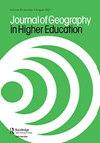通过统计学教学的创新吸引地理学生
IF 1
4区 教育学
Q2 EDUCATION & EDUCATIONAL RESEARCH
引用次数: 0
摘要
摘要地理专业本科生具有广泛的学术背景;因此,统计学教学尤其具有挑战性。不幸的是,缺乏关于地理学士学位课程统计学教学法的最新和特定于地理的文献。在本文中,我们详细介绍、讨论并反思了一系列旨在提高参与度和成就感的创新尝试。许多例子都围绕着技术平台展开,以提高学生的参与度,同时也改善和简化模块管理,这是交付团队教学模块中被低估的一部分。我们讨论了各种提问平台,将其作为让学生参与内容的有效方式,但也将其作为一种脚手架教学方法,通过这种方法来衡量学生的理解力,并对内容进行动态调整。我们还强调,在课堂录音时代,频繁使用形成性提问可以通过大幅增加出勤率来提高模块参与度。我们还反思了疫情前后参与方面的差异。总的来说,我们强调了将技术纳入地理统计教学的好处,但也提醒说,这必须根据具体情况进行,并且应该出于明确的教学原因使用。本文章由计算机程序翻译,如有差异,请以英文原文为准。
Engaging geography students through innovation in statistics teaching
ABSTRACT Geography undergraduate students have broad academic backgrounds; consequently, teaching statistics can be especially challenging. Unfortunately, there is a lack of up-to-date and geography-specific literature on the pedagogies of statistics instruction on an undergraduate geography degree course. In this paper we detail, discuss, and reflect on a range of innovative attempts to improve engagement and attainment. Many of the examples revolve around technological platforms to enhance student engagement, but also to improve and simplify module management, an under-valued part of delivering a team-taught module. We discuss a variety of quizzing platforms as effective ways of engaging students with content, but, also, as a method of scaffolding teaching, whereby student comprehension is gauged, and content is adapted on-the-fly. We also highlight that use of frequent formative quizzing can increase module engagement through a substantive increase in attendance in an era of lecture recording. We also reflect on differences in engagement pre-and-post pandemic. Overall, we highlight the benefit of incorporating technology into teaching geographical statistics, but caution that this must be on a case-by-case basis and should be used for clear pedagogical reasons.
求助全文
通过发布文献求助,成功后即可免费获取论文全文。
去求助
来源期刊

Journal of Geography in Higher Education
Multiple-
CiteScore
5.80
自引率
9.50%
发文量
29
期刊介绍:
The Journal of Geography in Higher Education ( JGHE) was founded upon the conviction that the development of learning and teaching was vitally important to higher education. It is committed to promote, enhance and share geography learning and teaching in all institutions of higher education throughout the world, and provides a forum for geographers and others, regardless of their specialisms, to discuss common educational interests, to present the results of educational research, and to advocate new ideas.
 求助内容:
求助内容: 应助结果提醒方式:
应助结果提醒方式:


